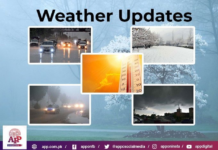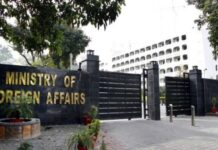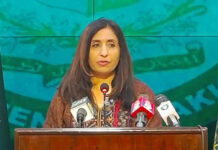ISLAMABAD, Jul 26 (APP):Amidst Karachi’s growing concrete jungle, mangrove forests which protect the city’s coastline against cyclones, strong winds, coastal flooding or other climate change induced disasters, face serious threat of destruction.
A recent report by WWF-Pakistan has identified several locations along the Karachi coast where significant tracts of mangroves have been cleared for housing schemes and commercial and industrial projects. The report also highlighted areas where mangrove landscapes were still under threat of massive deforestation.
It proposed that to stop mangrove destruction along the coastline of Karachi, it is essential to implement strict enforcement of laws and encourage reforestation and natural regeneration programmes. It warned that if preventive measures are not taken in time, existing mangrove areas could potentially be removed or destroyed in the near future.
Using Earth Observation Satellites, Remote Sensing and GIS tools, geospatial experts at the Richard Garstang Conservation Lab at WWF-Pakistan recorded data on mangrove cover in Karachi over the last two decades. They found that land reclamation and cutting of mangroves for housing schemes and development projects have resulted in the rapid decline of mangrove cover in Karachi.
Based on this report, WWF-Pakistan emphasized the need to prevent the further destruction of mangroves along Karachi’s coastline through better planning, effective implementation strategies, and coordinated actions by relevant organizations and departments.
The Sindh Forest Department (SFD) has been making significant progress in the conservation and management of the mangrove forests in the province. The department planted mangroves on 55,555 hectares along the Sindh coastline, mainly in the Indus Delta, through their ambitious projects between 2020 and 2024.
They also initiated various mangrove reforestation and management programmes in collaboration with WWF-Pakistan and the International Union for Conservation of Nature Pakistan (IUCN). As a result of these efforts, Pakistan’s mangrove forest cover has increased from 1,338.16 km2 in 2016 to 1,573.57 km2 in 2020 [REDD+; Subnational GHG Inventory 2022].
Despite these efforts by the department and mangrove plantation drives by conservation organizations, Pakistan Navy and local communities dwelling in the coastal belt, mangroves are facing significant threats in Karachi. According to the SFD, approximately 200 hectares of mangrove forests along Karachi’s coastline were lost between 2010 and 2022. This concerning trend is predominantly driven by land grabbing, residential schemes and development projects.
Satellite-based evidence of mangrove destruction along the Karachi coast provided by WWF-Pakistan’s GIS lab indicated that large tracts of mangroves, highlighted by the red lines on the images from 2000 and 2024, have been completely cleared and converted into residential projects.
The regions outlined in yellow are the areas where mangrove cutting is still occurring at an alarming rate. The blue-lined areas represent mangrove habitats that have been encroached or are currently under threats for residential, recreational, or industrial uses.
A common pattern of mangrove clearing observed involves the gradual cutting of trees adjacent to existing houses, leading to the encroachment of entire neighbourhoods, and the eventual development of dwellings, markets, parks, and industries.
Commenting on the report, Hammad Naqi Khan, Director General, WWF-Pakistan said that these vital mangrove forests are severely threatened by rampant urban development, illegal logging, pollution, and insufficient enforcement of conservation laws.
He said that this loss of mangrove cover along the coastline has not only increased the vulnerability of local communities to oceanic disasters but also eliminated other essential services including biodiversity support, urban cooling, air purification and storage of carbon dioxide.
The destruction of Karachi’s mangroves jeopardizes not only the environment but also the city’s sustainability and resilience against climate change. Khan suggested that given the ecological, economic, and social benefits of mangroves, relevant stakeholders must work together to conserve and manage these important natural resources.
This body of work found that land reclamation is one of the main causes of mangrove destruction in Karachi. As the city expands due to increasing urbanization, mangrove areas are being cleared to make way for residential, commercial and industrial development projects. Illegal land allotments have further worsened the situation, with large areas of mangrove land being allocated for construction, sometimes through a nexus between powerful individuals and land mafias.
These plots are sold at high prices, leading to further destruction of the mangrove ecosystem. This relentless development is driven by short-term financial gains, overlooking the long-term cost of environmental consequences.
It was also revealed that in addition to land reclamation, the cutting of mangroves for commercial use posed a significant challenge to the mangrove ecology. Mangroves loggers are clearing mature trees in the vicinity of Port Qasim, which is seriously impacting the entire ecosystem.
It emerged that the loggers generally target mature trees, which are about 30 feet high and have 2-6 inches trunk diameter. They cut such trees and leave them there to dry for a week or longer, after which they are collected for transportation to the local market.
The report points out that these critical areas should be protected as they help mitigate the adverse impacts of climate change and natural disasters and provide livelihood support to local fisher communities. It is recommended that continuous monitoring and research utilizing advanced tools such as satellite imagery will be crucial to track changes in mangrove cover and assess the effectiveness of conservation measures.
مضمون کا ماخذ : jogos de azar no Brasil














